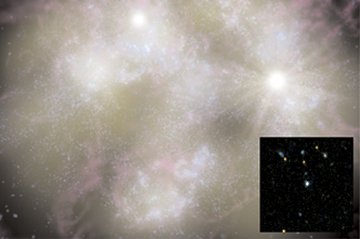Youthful versions of massive galaxies like our Milky Way may be only a cosmic stone’s throw away. That’s the finding of an ultraviolet-detecting satellite that has identified 36 such galaxies.

Since 1995, astronomers have detected more than 2,000 baby galaxies, virtually all of which reside more than 10 billion light-years away and therefore hail from the distant past (SN: 2/7/98, p. 92). These remote galaxies, aflame with newborn stars, have garnered attention because they’re the suspected building blocks of large, mature galaxies such as the Milky Way. But their distant locations make the building blocks difficult to study.
Now, scientists have for the first time detected galaxies that resemble these youngsters but reside just 2 to 4 billion light-years from Earth. The finding should enable astronomers to learn more about what large galaxies looked like in their infancies. At the same time, the very existence of these galaxies so near to Earth provides a mystery.
“It’s sort of like finding a dinosaur in your backyard,” says Tim Heckman of Johns Hopkins University in Baltimore.
“We thought this type of galaxy had gone extinct,” he adds. Star-forming galaxies were common when the universe was young, but most apparently coalesced into even larger galaxies.
To find the young galaxies, Heckman, Chris Martin of the California Institute of Technology in Pasadena, and their colleagues used the 0.5-meter ultraviolet telescope on the Galaxy Evolution Explorer (GALEX) satellite, which was launched in 2003. The newfound galaxies were detected because the GALEX satellite scans large swatches of the sky, says Martin. The team determined the distances to the galaxies using visible-light observations from the Sloan Digital Sky Survey, an ongoing study of the northern sky.
The researchers reported their findings during a Dec. 21 NASA briefing and also describe the study in an upcoming Astrophysical Journal Letters.
Because newborn stars radiate most of their light at ultraviolet wavelengths, their host galaxies appear to GALEX like diamonds against a black backdrop. Each galaxy emits about 10 times as much ultraviolet light as does the Milky Way, and they are “dead ringers” for the much more common, young, and massive galaxies found in the early universe, Heckman says.
“It’s interesting to have [these] analogs nearby because we can potentially get
much more-detailed and high-quality information about a lot of the fundamental processes involved in galaxy formation,” comments Alice Shapley of the University of California, Berkeley.
Astronomers now want to determine whether they’ve captured the newfound galaxies forming stars for the first time or whether the images represent galaxies undergoing the latest of many episodes of star formation, notes Shapley. For instance, collisions could have triggered a new episode of star birth in these galaxies.
Martin says that ultrasharp images that he hopes to take with the Hubble Space Telescope could reveal whether the galaxies have indeed been bent out of shape by a major collision.







